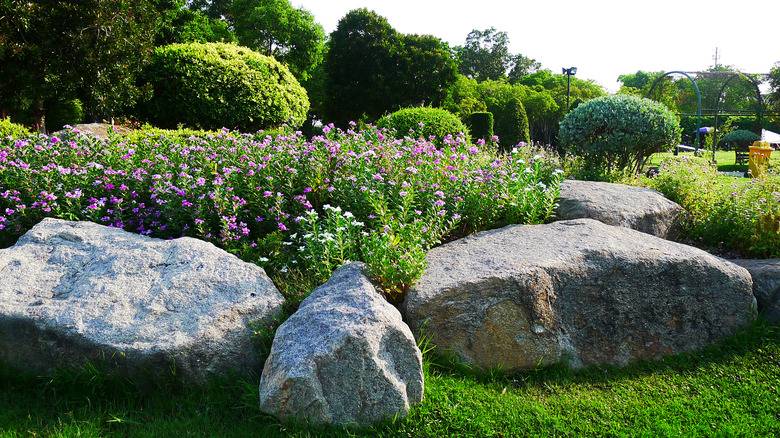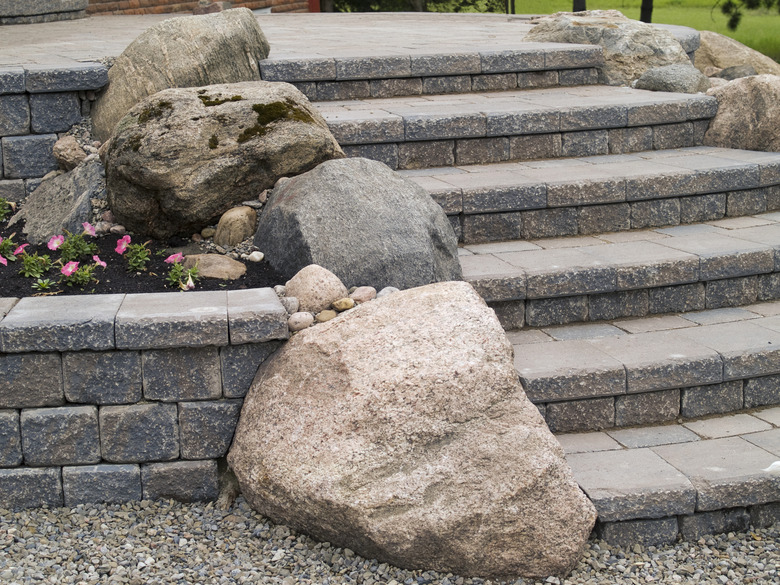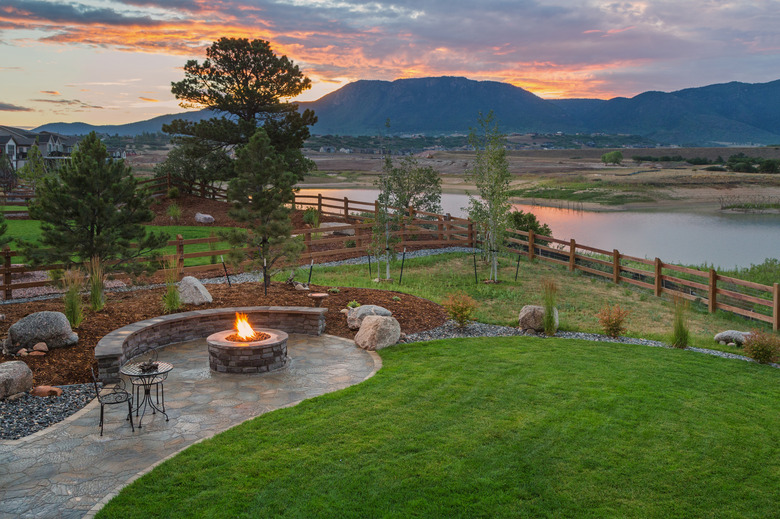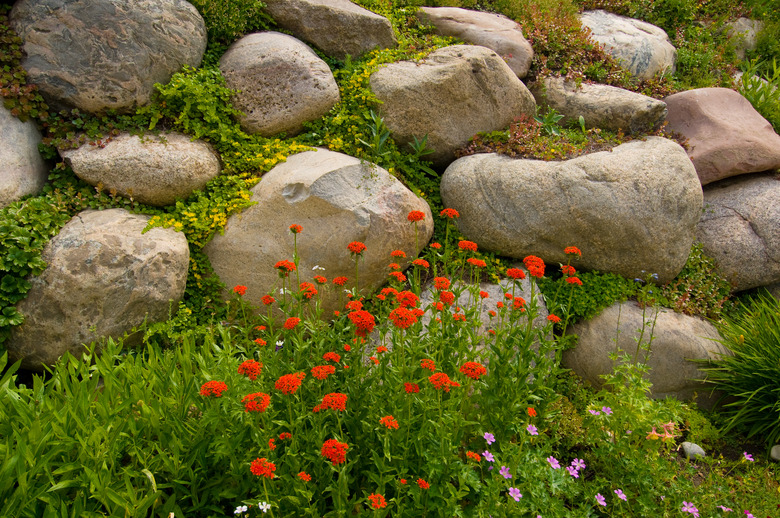A DIY Homeowner's Guide To Landscape Boulders
We may receive a commission on purchases made from links.
Landscape boulders can serve a variety of different functions, and they make an attractive addition to the exterior area of a home. Those who enjoy a natural look will appreciate the appearance of boulders, but these stone marvels can serve practical functions in the landscape as well. There are some DIY projects that can be done with landscape boulders, but professional help is often needed due to the sheer weight of these stones. Boulders can be incorporated in nearly any style of landscaping, making them quite versatile.
Tracking down boulders for use in a landscape design can be a bit labor intensive. These large rocks are usually found at landscape suppliers or quarries and are often priced by the ton. Some websites may have photos of the boulder types they carry, but selecting individual pieces needs to be done in person, as the look of each stone can vary widely.
Size and Shape of Landscape Boulders
Size and Shape of Landscape Boulders
According to Southwest Boulder & Stone, pieces of stone that are 16 inches in diameter and larger are considered boulders, with small ones coming in at under 2 feet in diameter. Even these rocks can be extremely heavy, with the weight of a granite boulder estimated at around 165 pounds per square foot. Landscaping boulders go up in size from there and can get quite large. Most homeowner projects will incorporate small- to medium-sized boulders.
While the exact definition of a boulder can vary slightly, it's always helpful to keep stone size in mind when doing the initial layout of the landscape. Selecting boulders that are too small won't have the impact desired, and they can get lost in plantings. Choosing boulders that are too large can be costly and can wind up looking odd or out of place in the overall landscape design.
Boulders come in various shapes, providing a range of styles and looks for the landscape. Some are jagged and angular, while others may have a flat side or a more rounded appearance. Rounded stones may complement a pond area, unusually shaped pieces may serve as interesting accents in a garden and flat-top boulders are a great choice for seating. Ultimately, choosing the shapes is really just a matter of taste and how they will function, as any of them can work nicely in a landscaping design.
Some people see large boulders as a unique piece of art and like to choose each stone carefully for appearance and size. Others use these pieces as a more practical part of the design, such as for front yard steps or a garden bench. Size and shape are two fundamental choices that need to be made early on when using boulders in a landscaping project.
Landscaping Boulder Materials
Landscaping Boulder Materials
There is a wide variety of landscaping boulders available. Some of the more popular stones include granite, limestone, sandstone and fieldstone, but there are other choices as well. Select a boulder that matches your sense of style as well as one that complements the house. Some boulders tend to blend into the background. Others may be more of a focal point. It's also fine to mix and match boulder materials if it suits the overall design.
Landscape boulders are basically large hunks of natural stone, which means they come in colors ranging from green hues to pink, brown and more. It can be a smart choice to select boulders that are native to the area. Not only will this look keep with the surroundings, but it could even wind up being less expensive since the materials are locally available. In addition, the boulder material should be a good match for the climate so that it holds up well over time.
Creative Landscaping With Boulders
Creative Landscaping With Boulders
Boulders can be included in a landscaping design in many different ways. Sometimes, it can be as simple as choosing a few large rocks to serve as a focal point in a flower bed. Boulders with a flat top can be placed around a fire pit to be used as seating, making a nice, natural-looking alternative to lawn chairs. Some may also be shaped and set to serve as attractive steps in a front yard. There are countless ways to include these interesting pieces in the landscape of a home.
Many people enjoy using boulders in areas with water features. They can be grouped at the waterfall area of a pond, staggered around a hot tub for privacy or carved out and used as a fountain. The natural look of large stone works well when mixed with water. Another popular way to use boulders is to include them in an overall design for a garden. Large stones provide another level of interest among all the greenery and add a different type of material to the mix.
Retaining walls can be fashioned from natural stone, and boulders make a beautiful foundation piece for this type of structure. This is one type of stone work that should almost always be left to a professional, however, as there is a large amount of labor involved as well as engineering for safety and effectiveness. Boulders can also serve as a lot demarcation and a type of fence material when dropped in to outline the border of a property.
Boulders can be effectively used for interest in a rock garden alongside smaller stones and rocks. This can be a good strategy to replace grass in areas that don't receive a lot of rain. Another way to incorporate boulders is to plan a Japanese garden. There are set principles for laying out rocks in this type of design, making it a very interesting landscape project. Refer to the book "Sakuteiki: Visions of the Japanese Garden: A Modern Translation of Japan's Gardening Classic" for a more in-depth look at this option.
DIY Boulder Projects
DIY Boulder Projects
Some boulder projects may not require enlisting the help of a landscape professional. If you are using small boulders for a little "pop" in a garden or front yard, it might be possible to work with a wheelbarrow and a few friends to get the job done. Sometimes, stones can be rolled or lifted in place with a bit of muscle. Just remember that it is easy to underestimate how heavy a boulder may be by just looking at it. If a boulder can't be loaded into a vehicle without machinery, it's likely too heavy for DIY placement at home.
Attending to a few practical items can make sure things stay looking their best in the yard. Be sure to use landscape fabric underneath areas where boulders are grouped (prior to setting the stones) to keep weeds from taking hold. Mulch can also be helpful for weed control. In addition, many of these large stones can benefit from being dug down and set into gravel to make sure they don't shift around in the cycle of the ground getting wet and drying out or from the freeze/thaw cycle.
Tips for Landscaping With Boulders
Tips for Landscaping With Boulders
There are a number of little tips and tricks to keep in mind when using boulders in a landscape design. Taking these into account can help everything look more natural and can highlight the beauty of these natural stone pieces. Most landscape designers will automatically incorporate these principles, but it's good to be aware of them if it's going to be a DIY project so the work looks as professional as possible.
Be sure to take plantings into account when it comes to setting boulders. Check with a home and garden store for suggestions, order from an online supplier or pick out something at a home improvement store. Just be sure that it is a good match for the location where the boulder will rest so the plant can grow easily. Also remember that the surface of a large rock can give off quite a bit of heat if it is exposed to the sun.
Another thing to take into consideration is the best "face" for larger stones. This means making an effort to present their best-looking side to the place it will be most easily seen. Also keep in mind that nature isn't usually orderly, so grouping boulders in odd numbers and natural arrangements will likely look better than pairing them up neatly. Choosing boulder sizes and deciding on placement can be challenging. Working with a landscape designer is an option that can be worth investigating.
Working With a Landscape Designer
Working With a Landscape Designer
Because boulders can be tricky to move and place, a landscape designer can be worth hiring to assist you with this task. Any landscape designer worth hiring will take some time to listen and understand the client's vision for the property. An initial meeting is usually held to firm up the overall concept and give the designer something with which to work. The designer will then work on a plan that incorporates the boulders with any plantings, such as flower beds or groundcover plants. Once feedback is received on this concept design, the designer will make any changes and draw up a final landscape design for review and any last-minute tweaks.
If the boulder design is complex and involves a lot of structural work, a landscape architect may be better suited for the job. These professionals are adept at things such as analyzing drainage, engineering for stacking boulders safely or building staircases out of stone. Often, a landscape design company or landscape architect will work with a particular crew for projects, but if not, he can usually recommend someone to execute the design once everything is finished.
Hiring a Landscaping Company
Hiring a Landscaping Company
Homeowners who prefer to do the layout themselves will need to hire a landscaping company to do the work if the labor isn't going to be part of a DIY project. Many boulder projects in landscape design will require machinery and expertise. Depending on the size of the boulders, the crew will require access for equipment such as a skid steer (bobcat) or a backhoe. Discuss this with them ahead of time to make sure the clearances will work. If not, sections of fencing or other items may need to be removed. If that's not possible, the boulder size should be adjusted accordingly.
Communication is key when working with any contractor, and this is certainly true when talking about boulder placement. Find out what the company is responsible for and what will need to be completed ahead of time. For example, do they prepare the ground by digging down, laying gravel and/or installing landscaping cloth, or do they expect the homeowner to have things ready? Once the boulder is placed, it won't be easy to change anything. Also, don't forget to discuss the orientation of the stone.
Use Natural Stone recommends getting referrals as well as reviewing past work to make sure it lines up with your taste and preferences. Check reviews for reports of quality work and a good safety record and make sure the company has experience in the type of landscape project you have planned. For example, a water garden designer may not be qualified to install a large retaining wall.
Landscaping professionals can help identify the best stone for the region. They know how to set stone properly and have equipment that is specifically suited to moving large pieces of stone from one place to another. This is especially critical when the boulders are going to serve as any type of structural piece in order to make sure it is built according to the specs called for in the plan design.



